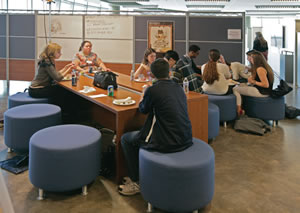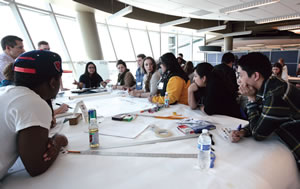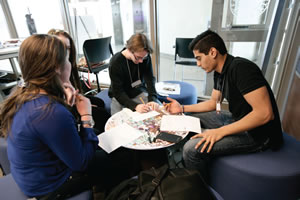21st-Century Learning Environments
- By Kenneth A. Gruskin, Michael Searson
- 02/01/16

PHOTOS COURTESY OF GRUSKIN ARCHITECTURE + DESIGN, P.C.
In contemporary society, new technologies support profound learning experiences across an array of environments. Visitors to the Smithsonian Institution in Washington, DC, can use an augmented reality app on their smartphones and see skeletons of mammals magically transformed with accurate renditions of skin and fur. An inexpensive pair of Google Cardboard virtual reality lenses allow viewers to experience three-dimensional views of Australia’s great barrier reef from anywhere in the world. Wearable fitness monitors make recommendations about optimum behavior for ideal health. Yet, we have made little progress in integrating such tools into formal learning environments.
While many institutions claim to have incorporated new media into their programs, few actually have done so in a meaningful way. Other than “tolerating” students’ use of mobile devices, for example, are they employed as tools to support rich dialogue and inquiry in learning environments? Do faculty seize the opportunity to use such tools as real-time response systems? Do learning spaces that support ubiquitous technology look and feel like computer labs or Starbucks? Are virtual-reality goggles seen as no more than gimmicks, devoid of meaningful educational value?
In the end, truly innovative learning environments can only be achieved through the seamless integration of pedagogy, technology and space, empowered by a supportive professional development program.

PHOTOS COURTESY OF GRUSKIN ARCHITECTURE + DESIGN, P.C.
Pedagogy
Preparation for the 21st-century workforce demands that educators shift the authority for learning to the students. After all, today’s workers are expected to function in collaborative and horizontal environments, as opposed to the “factory” driven, top-down, solitary worker spaces of yesterday. Therefore, contemporary learning environments should lean heavily on collaborative spaces, supported through personalized learning technologies. Good pedagogy encourages student engagement through complex collaborative projects based on real-world problems.
Leveraging today’s technologies would allow students from across the world to address complex, collaborative projects. For example, students outside of New York City and Shanghai could use tools that easily interface with their smartphones to collect, analyze and share data on water quality in the Hudson and Yellow Rivers, respectively. Then, using the same mobile devices, the students could engage in synchronous and asynchronous discussions on the implications of their data collection. Some actual examples include a U.S. Department of Defensefunded project that allows U.S. students to work with peers in Pakistan and India as they develop proficiency in Urdu and Hindi. Another comes from a Spanish professor who uses an off-the-shelf video game to allow students to put themselves into a virtual movie while using the target language they are studying.

PHOTOS COURTESY OF GRUSKIN ARCHITECTURE + DESIGN, P.C.
LUNCH AND LEARN. Wherever students meet, learning takes place. Surveys have revealed that many students report that their most memorable educational experiences took place outside of a typical classroom. With that in mind, providing students with the tools they need — from whiteboards to WiFi — to exchange ideas and information in spaces where they gather allows learning to occur.
Technology
Innovative learning should incorporate a true BYOD (bring your own device) environment that provides opportunities for student-centered learning, beginning with their own personalized technologies — from laptops and tablets to smartphones and wearable devices. This approach leverages student devices and reduces the need for institutionally provided equipment. For example, informal learning spaces with open WiFi access and inexpensive charging stations can replace over-reliance on traditional computer laboratories. Such activities would reflect a general trend across society, where access to high-speed bandwidth has leveled off, as people seem to prefer the immediacy of access through cell-driven communications.
Space and Learning Environments
Environments that meaningfully prepare students to excel in the 21stcentury workforce must facilitate new and engaging ways for students and faculty to interact and communicate. These spaces must support productive socialization, rich engagement, collaboration and meaningful study, both inside and outside the classroom. They must incorporate the infrastructure to support the technologies of today and tomorrow, while allowing real-time adjustments to support the pedagogy being used.
Reimagining every space, nook and cranny as a place for learning should be considered. Hallways should be designed as flex spaces, lounges, breakout spaces, intimate nooks and even places for small classes. When possible, access to outdoor spaces complete with seating and tables should be provided. When we asked students and educators from around the world to describe their most memorable educational experiences, they almost always occurred outside of the classroom.
This supports a growing trend where the “Googles” of the world are hiring individuals who have the right attitude, aptitude and work styles to fit into their cultures of collaboration, innovation and problem solving, rather than hiring for a specific job. Therefore, what makes these spaces especially critical to students are the styles of collaboration, engagement and interaction that these innovative learning environments foster, preparing students for the work environments found in the world’s leading companies.
But what makes a space or environment truly an innovative learning environment? Not surprisingly, it is some of the same characteristics that create outstanding and productive work environments. Some of these defining features are:
Engagement
Innovative learning spaces should provide exciting ways for students (and faculty) to connect, collaborate and learn from each other. Different types and styles of gathering spaces and integrated technologies allow students to be engaged both inside and outside the classroom. For today’s digital natives, low-tech solutions like magnetic whiteboards set within tackable acoustic panels can be distributed throughout hallways, lounge areas and other gathering spots to encourage both students and teachers to personalize their environments and engage with each other. Monitors placed both in and outside of classrooms can encourage digital dialogues with ongoing “back-channel” conversations where students and teachers can communicate in real time, even outside actual classes.


PHOTOS COURTESY OF GRUSKIN ARCHITECTURE + DESIGN, P.C.
EVERYTHING OLD IS NEW AGAIN. Spaces where students collaborate and create, sometimes referred to as makerspaces, encourage and enable them to invent, discuss, design and experiment while sharing ideas and knowledge. These brainstorming sessions are facilitated best by moveable, comfortable furniture and, if possible, reconfigurable walls, accompanied by surfaces whereon the students can record their discoveries. In many cases, paper and markers are as effective for these sessions as would be individual tech devices for sharing collective results.
Flexibility
Learning environments should be reconfigurable in real time, and negotiated by students themselves. Furniture should provide opportunities for physical movement, personal expression and socialization (both inside and outside the classroom) while facilitating improved learning outcomes through elevated student energy levels and engagement. Research suggests that people can focus on something for 15 to 20 minutes before they start to become distracted. Setting up a lesson plan that requires students to move and reconfigure the room every 20 minutes or so, to support different learning style activities, can help keep interest and focus.
Writing/brainstorming amenities such as tear-off paper tops can provide good old “analog” writing and drawing opportunities for small groups to engage sans technology. Ironically, students often find these “old school” approaches to be fresh and cool. Incorporating furniture designed to facilitate kinesthetic movement allow students to “remain in the present” as they spin, move and play.
Connection
Providing views into other learning and gathering spaces affords a greater sense of connection and community. It also creates interest, curiosity, cross-pollination opportunities and even serendipity, where students and faculty can spontaneously interact. Studies that look at creativity suggest that a little chaos goes a long way to enhancing creative thought and problem solving.
Context
Research suggests that a rich environment helps provide the basis for forming memories and learning. By altering the perception of the space through the real-time adjustment of placemaking attributes like graphics/artwork, lighting, smell, sound, furniture and partition arrangement, the typical “generic” educational facility can be endowed with “unique”
characteristics.
Views
Innovative learning spaces should endeavor to incorporate views to inspire and naturally improve educational outcomes. Research suggests that different types of views benefit specific types of thinking — long vistas and distant views have been associated with more creative thinking; constrained views appear to support analytical thinking.
Lighting
Varying light levels and color temperatures can unconsciously reinforce the varied types of educational activities and interactions that a space is facilitating.
Professional Development
While embracing new technologies presents exciting possibilities (and challenges) for novel models of learning, the role of professional development cannot be understated. Innovation alone will fail to provide any real benefit to challenge the orthodoxy of new learning spaces unless supported by rich pedagogies. Transformation of formal educational systems will require thorough and ongoing professional development to seamlessly integrate the possibilities that reimagined spaces, along with creative design, can afford rich learning environments. Said another way, “if you build it, they will not necessarily come.” So, when you build it, make sure they know how to use it!
In a recent project with open, flexible teaching environments, an instructor voiced concern at the lack of traditional enclosed classrooms and the anticipated noise from the adjacent spaces. She eventually adapted her teaching style to align with the promise of the environment. Had she been provided appropriate professional development as part of her introduction to this new teaching space, she would have likely embraced the initiative sooner and with less reluctance.
We also need to keep in mind the perspective of the learner who has years (if not decades) of experience with highly structured educational models, where there is a single authority for knowledge, usually at the front of the room. Such students need to be released from these constraints and given more authority and freedom for their own learning. In these situations, students need to be educated on how to use and benefit from a less-traditional learning environment — they need permission to engage and interact in a manner that is inconsistent with and even challenges their previous educational experiences.
In the end, pedagogy, technology and space must all be considered and integrated to create innovative learning environments. Professional development programs are equally critical if the teachers charged with using these innovative learning spaces are to be properly prepared to capitalize on the unique opportunities they afford. Ignoring even one of these core aspects will undermine the important initiative and investment being made to educate a workforce that is able to address 21st-century global challenges.
This article originally appeared in the issue of .